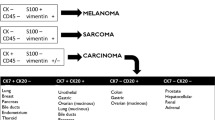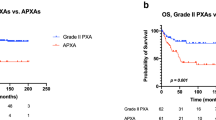Abstract
Purpose
To evaluate the clinical features and treatment results of anaplastic histology (AH) Wilms’ tumor (WT) patients registered in the Japan Wilms’ Tumor Study (JWiTS) group to elucidate the clinical characteristics of AH in the Japanese population.
Patients and methods
Of 344 WT patients who were enrolled in JWiTS between 1995 and 2013, 17 had AH. Treatment using the JWiTS protocols was similar to the fifth National Wilms’ Tumor Study 5 (NWTS-5) protocols. Clinical characteristics and mutation status of TP53 gene were evaluated and compared with those in NWST-5 study.
Results
AH incidences in JWiTS were 4.9 %, lower than that in NWTS-5. Seven tumors had focal AH and 10 had diffuse AH. Clinical stages of AH patients were stage I in seven, stage II in three, stage III in five, stage IV in one and unknown in one. Four-year event-free survival and overall survival rates were 90.9 and 86.7 %, respectively. Two patients with diffuse AH and none with focal AH had TP53 mutation.
Conclusion
Japanese patients presented with higher incidence, earlier stages and may have better outcomes than American patients, indicating a possible biological heterogeneity of AH WT. Further analysis is necessary to elucidate the different characteristic of AH WT between Japanese and American populations.



Similar content being viewed by others
References
Beckwith JB, Palmer NF (1976) Histopathology and prognosis of Wilms tumor. Cancer 41:1937–1948
Bonadio JF, Storer B, Norkool P et al (1988) Anaplastic Wilms’ tumor: clinical and pathologic studies. J Clin Oncol 3:513–520
Zuppan CW, Beckwith JB, Luckey DW (1988) Anaplasia in unilateral Wilms’ tumor: a report from the National Wilms’ Tumor Study Pathology Center. Hum Pathol 19:1199–1209
Vujanic GM, Harms D, Sandstedt B et al (1999) New definitions of focal and diffuse anaplasia in Wilms tumor: the International Society of Paediatric Oncology (SIOP) experience. Med Pediatr Oncol 32:317–323
Hill DA, Shear TD, Liu T et al (2003) Clinical and biologic significance of nuclear unrest in Wilms tumor. Cancer 97:2318–2326
Faria P, Beckwith B, Mishra K et al (1996) Focal versus diffuse anaplasia in Wilms tumor-new definitions with prognostic significance. Am J Surg Pathol 20:909–920
Dome JS, Cotton CA, Perlman EJ et al (2006) Treatment of anaplastic histology Wilms’ tumor: results from the fifth National Wilms’ Tumor Study. J Clin Oncol 24:2352–2358
Oue T, Fukuzawa M, Okita H et al (2009) Outcome of pediatric renal tumor treated using the Japan Wilms Tumor Study-1 (JWiTS-1) protocol: a report from the JWiTS group. Pediatr Surg Int 25:923–929
Grundy PE, Green DM, Coppes MJ et al (2002) Renal tumors. In: Pizzo PA, Poplack DG (eds) Principles and practice of pediatric oncology. Lippincott Williams Wilkins, Philadelphia, pp 865–893
Sugawara W, Arai Y, Kasai F et al (2011) Association of germline or somatic TP53 missense mutation with oncogene amplification in tumors developed in patients with Li-Fraumeni or Li-Fraumeni-like syndrome. Genes Chromosomes Cancer 50:535–545
Kaplan EL, Meier P (1958) Nonparametric estimation from incomplete observations. J Am Stat Assoc 53:457–481
D’Angio GJ, Breslow N, Beckwith JB et al (1989) Treatment of Wilms’ tumor: results of the Third National Wilms’ Tumor Study. Cancer 64:349–360
Green DM, Beckwith JB, Breslow NE et al (1994) Treatment of children with stages II to IV anaplastic Wilms’ tumor: a report from the National Wilms’ Tumor Study Group. J Clin Oncol 12:2126–2131
Pein F, Pinkerton R, Tournade MF et al (1993) Etoposide in relapsed or refractory Wilms’ Tumor: a phase II study by the French Society of Pediatric Oncology and the United Kingdom Children’s Cancer Study Group. J Clin Oncol 11:1478–1481
Bardeesy N, Falkoff D, Petruzzi MJ et al (1994) Anaplastic Wilms’ tumour, a subtype displaying poor prognosis, harbours p53 gene mutations. Nat Genet 7:91–97
Maschietto M, Williams RD, Chagtai T et al (2014) TP53 mutational status is a potential marker for risk stratification in Wilms tumour with diffuse anaplasia. PLoS One 9:e109924
Takeuchi S, Bartram CR, Ludwig R et al (1995) Mutations of p53 in Wilms’ tumors. Mod Pathol 8:483–487
Li W, Kessler P, Williams BRG (2005) Transcript profiling of Wilms tumors reveals connections to kidney morphogenesis and expression patterns associated with anaplasia. Oncogene 24:457–468
Author information
Authors and Affiliations
Consortia
Corresponding author
Rights and permissions
About this article
Cite this article
Oue, T., Koshinaga, T., Takimoto, T. et al. Anaplastic histology Wilms’ tumors registered to the Japan Wilms’ Tumor Study Group are less aggressive than that in the National Wilms’ Tumor Study 5. Pediatr Surg Int 32, 851–855 (2016). https://doi.org/10.1007/s00383-016-3929-7
Accepted:
Published:
Issue Date:
DOI: https://doi.org/10.1007/s00383-016-3929-7




